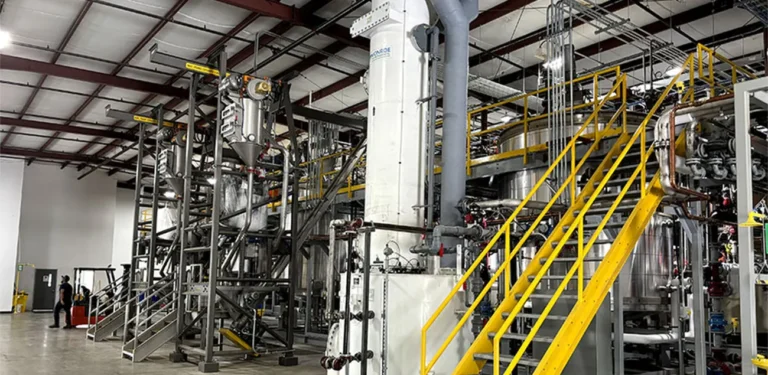
Physical and Chemical Properties of Palladium
Palladium (Pd) is a soft, silvery-white metal belonging to the platinum group metals (PGMs), widely valued for its catalytic properties, corrosion resistance, and hydrogen absorption capabilities.
Key properties include:
- Density: 12.02 g/cm³ — lighter than platinum but denser than silver.
- Melting point: 1,554°C (2,829°F), suitable for high-temperature industrial processes.
- Corrosion resistance: Palladium remains stable in air and resists attack by most acids.
- Hydrogen absorption: Palladium can absorb up to 900 times its own volume in hydrogen, making it critical for hydrogen storage and purification.
- Catalytic activity: It acts as a powerful catalyst for redox reactions, including carbon-carbon bond formation in organic synthesis.
These attributes make palladium essential across a variety of cutting-edge technologies and scientific applications.
Synthesis Methods of Palladium Nanoparticles
Palladium nanoparticles (PdNPs) are synthesized using diverse methods tailored for specific sizes, shapes, and surface chemistries. Common synthesis approaches include:
1. Chemical Reduction
Palladium salts (such as PdCl₂) are reduced using agents like sodium borohydride or hydrazine. Surfactants (e.g., PVP, citrate) are added to stabilize particles and control morphology.
2. Thermal Decomposition
This method uses organometallic palladium precursors that decompose under heat in organic solvents to form monodispersed PdNPs. It’s often applied for catalyst production with uniform particle size.
3. Electrochemical Deposition
4. Biogenic Synthesis
Eco-friendly "green" synthesis uses plant extracts or microorganisms to reduce Pd ions, offering sustainable alternatives with minimal toxicity — a growing trend in nanomedicine and environmental science.
The chosen synthesis method influences particle size, crystallinity, catalytic performance, and compatibility with various applications.
Industrial and Technological Applications
Palladium nanoparticles are central to numerous high-performance industrial processes. Key applications include:
- Catalytic converters: PdNPs help neutralize automotive exhaust gases (CO, NOx, hydrocarbons), contributing to cleaner air.
- Hydrogen technologies: Palladium membranes and catalysts purify hydrogen and support fuel cell operation.
- Electronics: Used in multilayer ceramic capacitors, connectors, and conductive films.
- Chemical synthesis: PdNPs catalyze cross-coupling reactions (e.g., Suzuki, Heck, Sonogashira), crucial for pharmaceuticals and fine chemicals.
Their large surface area and tunable activity make PdNPs superior to bulk palladium in many applications.
Palladium in Medicine and Healthcare
In biomedicine, palladium nanoparticles are emerging as multifunctional agents due to their biocompatibility, chemical reactivity, and easy surface modification.
Applications include:
- Cancer therapy: PdNPs are used in photothermal therapy, where they absorb light and convert it into localized heat to destroy tumors.
- Drug delivery: Functionalized PdNPs can carry and release therapeutic agents in a controlled manner.
- Antimicrobial agents: PdNPs disrupt microbial cell membranes, offering antibacterial coatings for medical devices.
- Diagnostic imaging: Their optical and catalytic properties enable use in biosensors and contrast agents.
These developments underscore palladium’s potential in personalized medicine and advanced diagnostics.
Environmental and Economic Significance
Palladium is a strategic material with strong implications for environmental protection and global markets.
Environmental Role
- Reduces urban air pollution via catalytic converters.
- Plays a key role in hydrogen purification, aiding the transition to clean energy.
- Increasing use in green chemistry as a recyclable catalyst.
Economic Importance
- Among the most valuable precious metals, palladium has outpriced gold at times.
- Supply is highly concentrated: Russia and South Africa account for the bulk of global output, making markets sensitive to geopolitical risks.
- Heavily traded on global commodity exchanges, influencing automotive and electronics industries.
Its dual value — as an industrial material and investment asset — underscores its importance in both technology and finance.
Fascinating Facts and Trivia
- Palladium was discovered in 1803 by William Hyde Wollaston and named after the asteroid Pallas.
- It is about 30 times rarer than gold and more expensive during periods of high automotive demand.
- PdNPs are used in hydrogen-sensing tattoos, a cutting-edge research concept for monitoring metabolism.
- Some forms of "palladium black", a fine powder, are highly active catalysts in chemical reactions.
- Palladium’s role in zero-emission technologies makes it one of the metals central to the energy transition.
FAQ
What are palladium nanoparticles?
Palladium nanoparticles are ultra-small particles (1–100 nm) of palladium metal with enhanced catalytic, electronic, and optical properties, widely used in clean energy, medicine, and industrial catalysis.
What are Pd metal nanoparticles used for?
Pd nanoparticles are used in:
- Catalytic converters to reduce car emissions.
- Fuel cells and hydrogen purification systems.
- Cross-coupling reactions in pharmaceuticals.
- Cancer therapy and biosensing.
- Microelectronics and antimicrobial coatings.
What are the applications of Pd nanoparticles?
Applications span:
- Automotive (emissions control).
- Energy (fuel cells, hydrogen storage).
- Medicine (therapeutics and diagnostics).
- Electronics (capacitors, sensors).
- Fine chemicals (organic synthesis).
What is the main use of palladium?
The main use of palladium is in automotive catalytic converters, where it helps transform harmful gases into less toxic substances, making it critical for environmental protection and emissions control.



